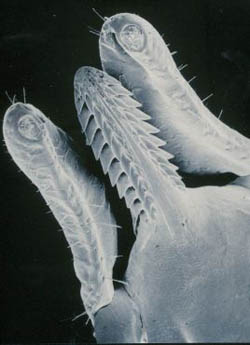Hypostome (tick)
Hypostome is a crucial anatomical structure found in ticks, which are ectoparasitic arachnids belonging to the subclass Acari. The hypostome plays a significant role in the feeding process of ticks, allowing them to anchor securely to their hosts while they feed on blood. This article delves into the structure, function, and importance of the hypostome in the biology of ticks.
Structure[edit | edit source]
The hypostome is located at the anterior end of the tick, beneath the capitulum or head. It is a harpoon-like structure, characterized by its elongated shape and the presence of backward-facing barbs or teeth. These barbs are crucial for the tick's ability to attach to the host's skin securely. The hypostome's anatomy varies among different tick species, with variations in the size, shape, and number of barbs, reflecting adaptations to their specific host preferences and feeding habits.
Function[edit | edit source]
The primary function of the hypostome is to facilitate blood feeding. Once a tick has selected a suitable feeding site on the host's body, it cuts through the skin using its chelicerae, another set of mouthparts. The hypostome is then inserted into the wound, anchoring the tick in place. The backward-facing barbs ensure that the tick remains firmly attached throughout the feeding process, which can last several days for some species. The hypostome also contains salivary ducts through which the tick secretes saliva. This saliva contains anticoagulants and immunomodulators that prevent blood clotting and modulate the host's immune response, facilitating uninterrupted feeding.
Ecological and Medical Significance[edit | edit source]
The efficiency of the hypostome in anchoring ticks to their hosts has significant ecological and medical implications. Ticks are vectors of a wide range of pathogens, including bacteria, viruses, and protozoa, which can cause diseases in humans and animals. Diseases such as Lyme disease, Rocky Mountain spotted fever, and tick-borne encephalitis are transmitted through tick bites. The secure attachment facilitated by the hypostome allows ticks to feed for extended periods, increasing the likelihood of pathogen transmission to the host.
Removal of Ticks[edit | edit source]
Due to the effectiveness of the hypostome in anchoring the tick, removing a tick from the skin can be challenging. It is recommended to use fine-tipped tweezers to grasp the tick as close to the skin's surface as possible and pull upward with steady, even pressure. This method reduces the risk of breaking the hypostome and leaving part of it embedded in the skin, which can lead to infection.
Conclusion[edit | edit source]
The hypostome is a key anatomical feature that enables ticks to feed effectively on their hosts, playing a critical role in their survival and reproductive success. Its design and function also contribute to the transmission of tick-borne diseases, highlighting the importance of understanding this structure in efforts to control tick populations and prevent disease.
Search WikiMD
Ad.Tired of being Overweight? Try W8MD's physician weight loss program.
Semaglutide (Ozempic / Wegovy and Tirzepatide (Mounjaro / Zepbound) available.
Advertise on WikiMD
|
WikiMD's Wellness Encyclopedia |
| Let Food Be Thy Medicine Medicine Thy Food - Hippocrates |
Translate this page: - East Asian
中文,
日本,
한국어,
South Asian
हिन्दी,
தமிழ்,
తెలుగు,
Urdu,
ಕನ್ನಡ,
Southeast Asian
Indonesian,
Vietnamese,
Thai,
မြန်မာဘာသာ,
বাংলা
European
español,
Deutsch,
français,
Greek,
português do Brasil,
polski,
română,
русский,
Nederlands,
norsk,
svenska,
suomi,
Italian
Middle Eastern & African
عربى,
Turkish,
Persian,
Hebrew,
Afrikaans,
isiZulu,
Kiswahili,
Other
Bulgarian,
Hungarian,
Czech,
Swedish,
മലയാളം,
मराठी,
ਪੰਜਾਬੀ,
ગુજરાતી,
Portuguese,
Ukrainian
Medical Disclaimer: WikiMD is not a substitute for professional medical advice. The information on WikiMD is provided as an information resource only, may be incorrect, outdated or misleading, and is not to be used or relied on for any diagnostic or treatment purposes. Please consult your health care provider before making any healthcare decisions or for guidance about a specific medical condition. WikiMD expressly disclaims responsibility, and shall have no liability, for any damages, loss, injury, or liability whatsoever suffered as a result of your reliance on the information contained in this site. By visiting this site you agree to the foregoing terms and conditions, which may from time to time be changed or supplemented by WikiMD. If you do not agree to the foregoing terms and conditions, you should not enter or use this site. See full disclaimer.
Credits:Most images are courtesy of Wikimedia commons, and templates Wikipedia, licensed under CC BY SA or similar.
Contributors: Prab R. Tumpati, MD

